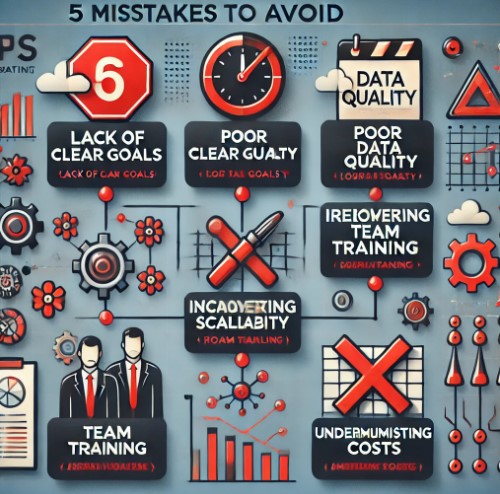Table of Contents
- 1 Introduction
- 2 Understanding AIOps
- 3 5 Mistakes to Avoid When Implementing AIOps
- 4 FAQs about Implementing AIOps
- 5 Conclusion
Introduction
As businesses strive to enhance their IT operations and improve efficiency, many are turning to AIOps (Artificial Intelligence for IT Operations) as a solution. AIOps combines AI and machine learning to automate and optimize IT processes, providing real-time insights and proactive issue resolution. However, implementing AIOps can be challenging, and missteps can hinder its effectiveness.
This article explores 5 Mistakes to Avoid When Implementing AIOps, offering insights on how to navigate these challenges and ensure a successful transition.
Understanding AIOps
What is AIOps?
AIOps leverages AI, machine learning, and big data analytics to monitor, analyze, and automate IT operations. It aims to enhance efficiency, reliability, and performance by providing real-time insights and automating routine tasks.
Benefits of AIOps
- Automation of routine tasks
- Proactive issue detection and resolution
- Enhanced data analysis and insights
- Scalability and flexibility
- Cost reduction and resource optimization
5 Mistakes to Avoid When Implementing AIOps
1. Lack of Clear Objectives and Goals
Why Clear Objectives Matter
Implementing AIOps without clear objectives can lead to misaligned expectations and suboptimal outcomes. Clear goals provide direction and help measure success.
How to Avoid This Mistake
- Set SMART Goals: Define specific, measurable, achievable, relevant, and time-bound goals for your AIOps implementation.
- Align with Business Strategy: Ensure that your objectives align with your overall business strategy and address specific challenges.
- Regular Reviews: Continuously review and adjust your goals based on feedback and evolving business needs.
2. Inadequate Data Management
The Importance of Data
Data is the foundation of AIOps. Inadequate data management can lead to poor performance, inaccurate insights, and ineffective automation.
How to Avoid This Mistake
- Data Quality: Ensure that the data collected is accurate, relevant, and up-to-date.
- Comprehensive Data Collection: Collect data from multiple sources, including logs, metrics, events, and traces.
- Data Integration: Integrate data seamlessly from various systems to provide a holistic view of IT operations.
3. Neglecting Change Management
The Role of Change Management
Implementing AIOps involves significant changes in processes and workflows. Neglecting change management can lead to resistance from staff and disruption of operations.
How to Avoid This Mistake
- Stakeholder Engagement: Involve key stakeholders from the beginning to gain their support and input.
- Communication: Clearly communicate the benefits and objectives of AIOps to all relevant parties.
- Training and Support: Provide comprehensive training and ongoing support to help staff adapt to new processes and technologies.
4. Overlooking Scalability and Flexibility
The Need for Scalability
As your business grows, your IT needs will evolve. Overlooking scalability and flexibility can limit the long-term effectiveness of your AIOps implementation.
How to Avoid This Mistake
- Scalable Solutions: Choose AIOps platforms that can scale with your business needs.
- Flexible Deployment: Opt for solutions that offer flexible deployment options, such as on-premises, cloud, or hybrid models.
- Future-proofing: Consider future requirements and ensure that the chosen solution can adapt to changing needs.
5. Ignoring Continuous Improvement
The Value of Continuous Improvement
AIOps is not a one-time implementation. Ignoring continuous improvement can result in stagnation and missed opportunities for optimization.
How to Avoid This Mistake
- Regular Monitoring: Continuously monitor the performance of your AIOps platform and processes.
- Feedback Loop: Establish a feedback loop to gather insights and make necessary adjustments.
- Innovation: Encourage a culture of innovation and continuous improvement within your IT team.
FAQs about Implementing AIOps
What are the primary benefits of AIOps?
AIOps enhances IT operations by automating routine tasks, providing real-time insights, proactively detecting and resolving issues, optimizing resource usage, and improving overall efficiency and reliability.
How can businesses ensure successful AIOps implementation?
Businesses can ensure successful AIOps implementation by setting clear objectives, managing data effectively, engaging stakeholders, choosing scalable and flexible solutions, and fostering continuous improvement.
What role does data play in AIOps?
Data is crucial for AIOps, as it provides the foundation for analysis, insights, and automation. High-quality, comprehensive data collection and integration are essential for effective AIOps.
Why is change management important in AIOps implementation?
Change management is important because AIOps implementation involves significant changes in processes and workflows. Effective change management ensures smooth transitions, staff buy-in, and minimized disruptions.
How can businesses promote continuous improvement in AIOps?
Businesses can promote continuous improvement by regularly monitoring performance, establishing feedback loops, encouraging innovation, and making ongoing adjustments based on insights and evolving needs.

Conclusion
Implementing AIOps can revolutionize IT operations, driving efficiency, reliability, and performance. However, to achieve these benefits, it’s crucial to avoid common pitfalls. By addressing the 5 Mistakes to Avoid When Implementing AIOps, businesses can navigate the challenges of AIOps implementation and maximize its effectiveness. Clear objectives, effective data management, comprehensive change management, scalability, and continuous improvement are key to a successful AIOps journey.
Embrace AIOps today and transform your IT operations for a more efficient and resilient future. By avoiding these common mistakes, you can unlock the full potential of AIOps and ensure sustained success in your digital transformation efforts. Thank you for reading the DevopsRoles page!
